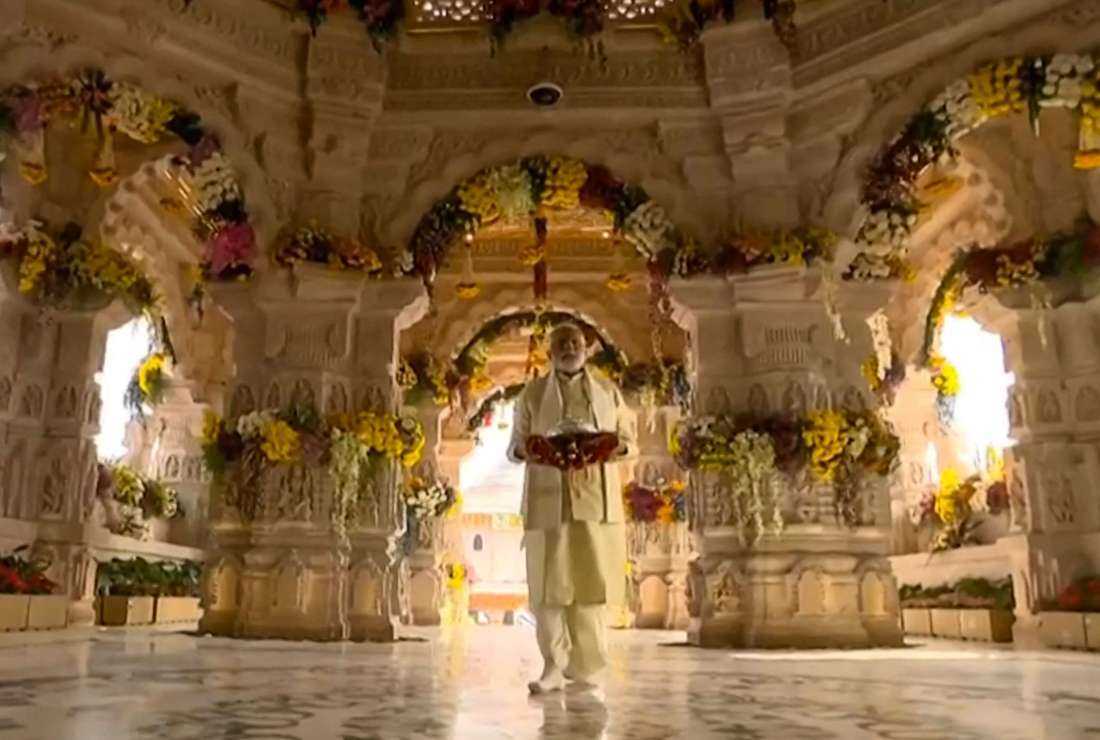
India’s Prime Minister Narendra Modi walks into the Ram temple to officially consecrate the temple in Ayodhya in India’s Uttar Pradesh state. Modi inaugurated the temple that embodies the triumph of his muscular Hindu nationalist politics on Jan 22, galvanizing loyalists in an unofficial start to his re-election campaign this year.
Ever since the grand opening, Hindus have made a beeline to this ancient town in northern India regarded as the birthplace of Ram, one of Hinduism’s most revered deities.
They are hailing Prime Minister Narendra Modi as their “civilizational hero” and his BJP sees a “huge electoral wave fueled by Lord Ram himself” in their favor.
The BJP has been projecting Modi as the prime minister who brought Ram back to his original home. The Hindu deity, according to the pro-Hindu party, had been displaced and has lived in exile since the Babri Masjid was built in the 16th century on the site believed to be his birthplace.
This project was decades in the making after a Hindu mob demolished the mosque on Dec. 6, 1992. The Indian prime minister not only brought Ram back but also transformed Ayodhya, a crumbling, dusty town on the banks of Saryu river, a tributary of the holy Ganges, into what Hindu nationalists have dubbed the “Hindu Vatican.”
Ayodhya now boasts a brand-new airport, an upgraded railway station, and luxury hotels with a capacity to welcome nearly 50 million religious tourists every year.
The BJP believes Modi is unbeatable. There is no opposition left to confront him at the hustings.
The Congress, which ruled India for years after independence in 1947, suffers from a serious leadership crisis. Its plan to forge an alliance of opposition parties is proving a non-starter.
On Jan. 28, a major alliance partner, Nitish Kumar, chief minister of eastern Bihar state and leader of Janata Dal-U (the United People’s Party) dumped Congress and its political partners to join hands with Modi’s BJP.
Before him, two other regional satraps, Mamata Banerjee, chief minister of West Bengal, and Arvind Kejriwal, chief minister of Delhi, also dissociated themselves from Congress.
“The message is clear. These leaders grounded in electoral reality are smartly distancing themselves from Congress, which is being seen as an anti-Hindu party,” says sociologist Tushar Bhadra from Varanasi in northern Uttar Pradesh.
Observers like him feel religion is no more about leading a traditional, peaceful way of life for the majority of Indians. It is a powerful tool that has changed the way they perceive politics. And one cannot blame the politicians alone for this change.
Bhadra has a point. The same people — politicians and intellectuals who once said a temple built on the ruins of a mosque cannot be considered a temple — are calling the idol of an infant Ram installed by Modi as a “national icon.”
Many among them, including non-Hindus, and Christians in particular, realize that the Western model of democracy adopted by India post-independence is on the wane.
The new India under Modi is not apologetic about its “Indianness” in the civilizational context and is certainly not defensive about Hindu culture.
There is a new school of thought, which says one cannot compare apples to oranges. A Masjid cannot be an inherent part of Indian history. The mosque in Ayodhya was called Masjid-e-Janmesthan (Mosque dedicated to the birthplace). How can there be such a name?
The proposition is that Hindus, who are democratic in thought, never asserted their collective power. They belong to different castes and follow various ways of worship.
But with the Ayodhya temple becoming a reality, Hindus have emerged as a united force and it is an occasion to celebrate.
But this cannot be an end in itself. It is just the first step and there is a clear road map ahead.
In 2024, India starts thinking of itself as a Hindurashtra (Hindu nation) beginning a new era of Hindu assertion.
“Smart politicians like Nitish Kumar realize this, and are hence joining the bandwagon led by Modi, to be on the winning side,” said a retired school teacher in Ayodhya.
Even the psephologists in New Delhi agree that the 2024 electoral battle in India might end up as a no-contest. “A Modi versus nobody scenario,” as one of them chose to describe it.
“The BJP is always in touch with ground reality. They have enough cadres and resources. And PM Modi is a mass-based, popular leader. No party in the opposition has the strength to take them on,” Janata Dal-U spokesman K C Tyagi told UCA News.
The message is clear — if you cannot fight Modi, it is better to join him.
